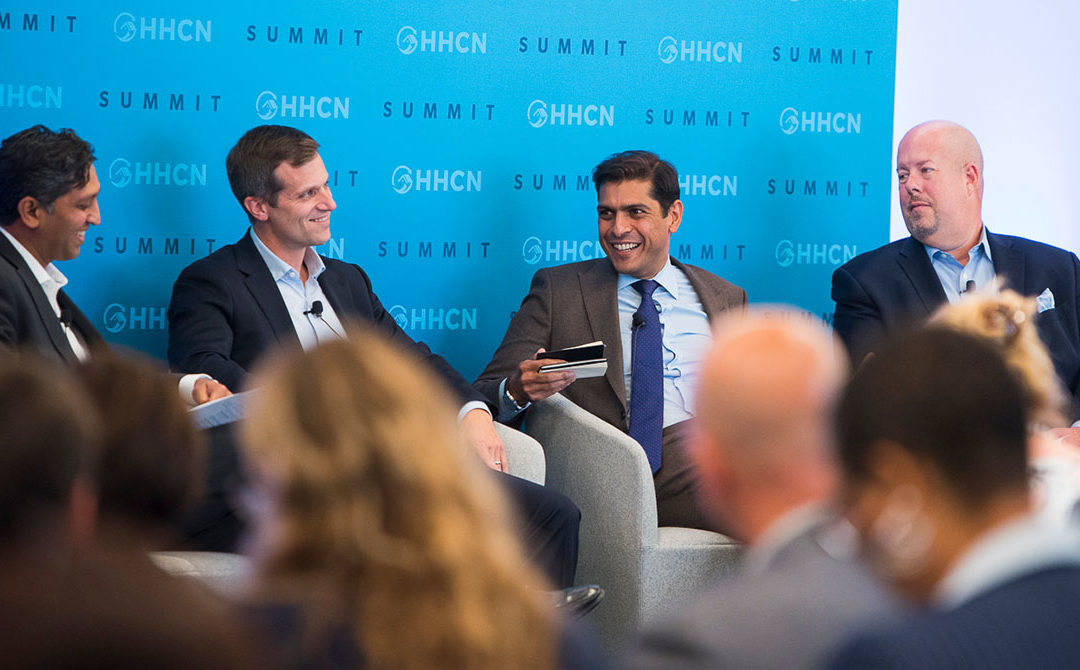
From left to right: Dina CEO Ashish V. Shah led a panel at the recent Home Health Care News Summit with David Baiada, CEO, BAYADA Home Health Care; Rajesh Aggarwal, senior vice president, Jefferson Strategic Ventures & Innovation, Thomas Jefferson University and Jefferson Health; and Joe Kiernan, chief strategy officer, Ocean Healthcare.
As integration and communication become critical to the success of patient outcomes, especially with senior patients, coordination through the continuum of care has become more sophisticated. Dina CEO Ashish V. Shah recently asked leaders from Jefferson Health, BAYADA Home Health Care and Ocean Healthcare to share strategies for building preferred provider networks and outcome-based partnerships. Here are some of the highlights from their discussion at the recent Home Health Care News Summit in Chicago:
Ashish V. Shah, Dina: David: As a multi-specialty home-based provider, you’ve spent a lot of time trying to fix some of the challenges around care coordination and transition, especially as patients move from hospital to home. Can you share your perspective?
David Baiada, BAYADA Home Health Care: I think care transitions are one of the worst experiences that people have to go through in life. For any of you who have had the responsibility or experience of navigating the journey from hospital to home, and then staying safe at home, it can often be terrible, even for those of us who do it for a living. And so we spend a lot of time internally getting our teams excited and energized to make it better. We think about basics: being really responsive, friendly, fast, easy to work with, great communication, these things that I think get skipped. That’s where it all starts.
“We have to lead the innovation to make it consistent.” David Baiada
Ashish V. Shah: How do you think about shared outcomes and the value that gets created, things that are perhaps difficult to get reimbursed for?
David Baiada: Consistency and creating standards is something we spend a lot of time thinking about. When we think about our hospital and skilled nursing partners, for example, how do we get clarity about mutual expectations and a commitment to certain standards, and then how do we measure it and hold each other accountable? We have some awesome examples of success, I’m sure we all do, but it’s not enough. I think one of our responsibilities is to send a message to the market. This is really hard and we have to lead the innovation that’s going to make it possible and make it consistent.
“It’s got to work for the patients.” Raj Aggarwal
Ashish V. Shah: Raj: Why does a health system care about partnering with home-care providers?
Raj Aggarwal, Jefferson Health: There’s a really simple answer: It’s the right thing to do, to look after patients when they’re outside of our four walls. And it’s not the traditional hospital model, where we care about you when you’re in our buildings and then it’s someone else’s problem. And so I don’t actually like the phrase “care transitions,” because that means you’re transitioning care from my team to another team–it’s your problem now.
Just to preface this, five years ago, Jefferson was a three-hospital, $1.5 billion entity in Philadelphia. We’ve grown remarkably through a series of mergers and acquisitions and we’re now a $5.1 billion health system, with 14 hospitals and 4.2 million annual patient encounters. We now have a responsibility to lead. People look up to us and we have to do the right thing. And doing the right thing is more than care transitions, more than my team and your team. It’s about creating a continuum of care. And the other key part of this is that it’s got to be patient-based. It can’t be based around what care coordination pathway works for the providers. It’s got to work for the patients.
We have a narrative at Jefferson whenever we want to do something: we can buy it, we can build it, or we can partner. Our approach is to partner. We have a strategic partnership with Prepared Health, underpinned with our relationship with BAYADA, and we’re working on a way to remain responsible for our patients who come to our hospital and then continue their care in another setting. We want to be alert in terms of how we care, regardless of where the patient is. So partnering with BAYADA, partnering with Prepared Health, it’s the right thing to do.
Ashish V. Shah: Can you talk about ROI and framing the business case for this?
Raj Aggarwal: I will, but that’s not where we should start. ROI measures should be in response to quality and what’s best for the patient. That’s what’s most important. Our ROI measures were derived from optimizing length of stay, reducing readmissions and reducing uncompensated care, because improving in all of those areas is good for patients. Yes, there is an ROI on that which is important, so when we partner with Prepared Health and partner with home care agencies, we can deliver the best care. But only focusing on the dollar without delivering that best care, it’s not going to work.
“Step outside your lane…that’s really where the higher-quality patient care and results are coming from.” Joe Kiernan
Joe Kiernan, Ocean Healthcare: In terms of ROI, the saying in our organization is “Do the right thing for the right reason and the money follows.” So that comes down to how you collaborate with your partners and how you coordinate those efforts, because it’s that individual life that you’re actually focusing on. Ocean Healthcare is a fairly large, but regionally based post-acute provider. We take care of about 5,000 patients a day, which is a pretty sobering mindset to have. We’re admitting to Jefferson, discharging to BAYADA, discharging within our own organization. The way that we’ve really made that work has been with a change in our culture. Today, it’s not just skilled nursing worrying about skilled nursing, and hospice just staying in their lane. We’re telling everybody to step outside your lane. That’s really where the higher-quality patient care and results are coming from.
Ashish V. Shah: How do you build preferred networks and then think about transitions to not only your own assets, but to partners.
David Baiada: We have a belief that there is an immense unmet need for the work that we do over the long run. Where I see things break down is when organizations squabble over referrals. I’m trying to figure out: How do we humanize strategic alignment? And it’s by sitting down and having a conversation. Let’s say there are a million people who live in this county. Some need our services today; a percentage will need our services five years from now. How do we set this up so we can all build a viable business and deliver an amazing service at the same time? These examples, with Jefferson and Ocean, these are communities where we have relationships, and we get in a room and set up a basic framework to align our services across 90 days so it’s good for patients and good for families. It’s not that complicated.
“Where I see things break down is when organizations squabble over referrals.” David Baiada
Joe Kiernan: And if you want to build relationships with upstream referral sources, get to them before they get to you. Make the phone call. Go in and set the tone and get a seat at the table. And have those conversations early on, because otherwise you’re going to come in a little too late and someone’s going to set the tone for you. But as home care or hospice or other post-acute providers, go into your hospital or go to your skilled nursing centers and your referral sources and say, “Here’s what we’re capable of, tell me what you need.” Figure out how to work together to have the best outcomes for patients, and do the right thing for the right reason, and a more positive financial and clinical outcome will follow.




